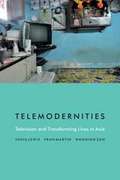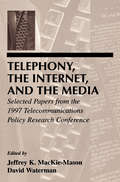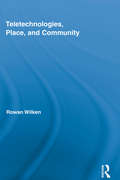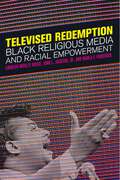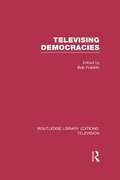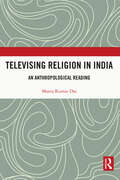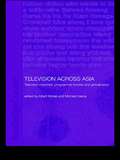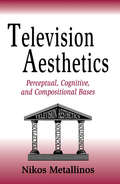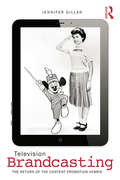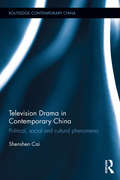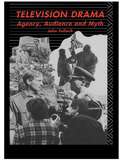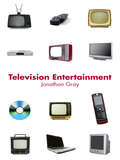- Table View
- List View
Telemodernities: Television and Transforming Lives in Asia
by Fran Martin Wanning Sun Tania LewisYoga gurus on lifestyle cable channels targeting time-pressured Indian urbanites; Chinese dating shows promoting competitive individualism; Taiwanese domestic makeover formats combining feng shui with life planning advice: Asian TV screens are increasingly home to a wild proliferation of popular factual programs providing lifestyle guidance to viewers. In Telemodernities Tania Lewis, Fran Martin, and Wanning Sun demonstrate how lifestyle-oriented popular factual television illuminates key aspects of late modernities in South and East Asia, offering insights not only into early twenty-first-century media cultures but also into wider developments in the nature of public and private life, identity, citizenship, and social engagement. Drawing on extensive interviews with television industry professionals and audiences across China, India, Taiwan, and Singapore, Telemodernities uses popular lifestyle television as a tool to help us understand emergent forms of identity, sociality, and capitalist modernity in Asia.
Telephony, the Internet, and the Media: Selected Papers From the 1997 Telecommunications Policy Research Conference (LEA Telecommunications Series)
by Jeffrey K. MacKie-Mason David WatermanCommemorating the 25th anniversary of the Telecommunications Policy Research Conference (TPRC), this volume begins with a historical survey of a quarter-century of TPRC meetings as one measure of change in and research about the telecommunications industry. Additional papers reflecting the ongoing pace of change in technological, economic, and policy issues are organized around four topics: * economic analysis of local and international telephone policy; * media industry studies including video competition, guidelines for children's educational television, and the setting of AM stereo standards; * applications and policy regarding the Internet; and * comparative studies in telephone and satellite policy. Collectively, the contents of this volume assess key issues for scholars, policymakers, and practitioners. Research reported in this volume illustrates the continually expanding scope of scholarly concerns about the telecommunications and information industry and contributes to further policy research and analysis.
Teletechnologies, Place, and Community (Comedia)
by Rowan WilkenTeletechnologies, or technologies of distance, cannot be ignored. Indeed, the present electronic age is said to have wrought profound changes to how we think about and experience who we are, where we are, and how we relate with one another. Place and community have traditionally formed key concepts for thinking about these issues, but what relevance do these concepts now hold for us? In this wide-ranging study, Wilken re-evaluates how ideas of place and community intersect with and help us make sense of a world transformed by information and communication technologies. This interdisciplinary investigation ranges across diverse textual and contextual terrain, exploring approaches from media and communications, architectural history and theory, philosophy, sociology, geography, literature, and urban design. The rich analysis of these myriad texts reveals the complex and at times contradictory ways in which notions of place and community circulate in relation to these technologies of distance. Wilken’s examination underscores both the enduring importance of ideas of place and community in the present age, and the urgent need to continue to engage with, think about and reconfigure these twin ideas.
Televised Redemption: Black Religious Media and Racial Empowerment
by Carolyn Moxley Rouse John L. Jackson Jr. Marla F. FrederickHow Black Christians, Muslims, and Jews have used media to prove their equality, not only in the eyes of God but in society. The institutional structures of white supremacy—slavery, Jim Crow laws, convict leasing, and mass incarceration—require a commonsense belief that black people lack the moral and intellectual capacities of white people. It is through this lens of belief that racial exclusions have been justified and reproduced in the United States. Televised Redemption argues that African American religious media has long played a key role in humanizing the race by unabashedly claiming that blacks are endowed by God with the same gifts of goodness and reason as whites—if not more, thereby legitimizing black Americans’ rights to citizenship. If racism is a form of perception, then religious media has not only altered how others perceive blacks, but has also altered how blacks perceive themselves. Televised Redemption argues that black religious media has provided black Americans with new conceptual and practical tools for how to be in the world, and changed how black people are made intelligible and recognizable as moral citizens. In order to make these claims to black racial equality, this media has encouraged dispositional changes in adherents that were at times empowering and at other times repressive. From Christian televangelism to Muslim periodicals to Hebrew Israelite radio, Televised Redemption explores the complicated but critical redemptive history of African American religious media.
Televising Chineseness: Gender, Nation, and Subjectivity (China Understandings Today)
by Geng SongThe serial narrative is one of the most robust and popular forms of storytelling in contemporary China. With a domestic audience of one billion-plus and growing transnational influence and accessibility, this form of storytelling is becoming the centerpiece of a fast-growing digital entertainment industry and a new symbol and carrier of China’s soft power. Televising Chineseness: Gender, Nation, and Subjectivity explores how television and online dramas imagine the Chinese nation and form postsocialist Chinese gendered subjects. The book addresses a conspicuous paradox in Chinese popular culture today: the coexistence of increasingly diverse gender presentations and conservative gender policing by the government, viewers, and society. Using first-hand data collected through interviews and focus group discussions with audiences comprising viewers of different ages, genders, and educational backgrounds, Televising Chineseness sheds light on how television culture relates to the power mechanisms and truth regimes that shape the understanding of gender and the construction of gendered subjects in postsocialist China.
Televising Democracies (Routledge Library Editions: Television)
by Bob FranklinPublished in 1992, this was the first book to assess the impact of television broadcasting on the House of Commons and its Member’s behaviour. It looks at the implications for political journalism as well as broader questions concerning the role of media in a democracy. Bringing together contributions from senior broadcasters, politicians from various parties and academics and researchers, the book approaches the issues from a range of different perspectives. The first section of the book focuses on broadcasters’ accounts of the difficulties involved in establishing the structure and organisation of Parliamentary broadcasting, while the second section gives politicians’ own assessments of the consequences of the admission of cameras to the House. The third section looks at the findings of research studies assessing the type of materials broadcast, the impact on political journalism, and audience responses. The fourth section draws comparison with the American, German and European experience of televising democracy.
Televising Religion in India: An Anthropological Reading
by Manoj Kumar DasThis book explores how religion manifests itself in television and popular media. It focuses on how religious tradition, practices and discourses have been incorporated into non-religious television programmes and how they bring both the community and the media into the fold of religion. The volume traces the cultural and institutional history of television in the state of Sikkim, India to investigate how it became part of cultural life of communities. The author has analysed three televised shows which captured the imagination of communities and became a ceremonial and religious practice. Through these case studies, he highlights how rituals and myths function in mass media, how traditional institutions and religious practices redefine themselves through their association with the visual mass medium, and how identities based on religion, cultural tradition and politics are reinforced, transformed and amplified through television. The book further analyses the engagement of televised religion with audiences, its reach, relevance and contents and its relationship with urbanity, tradition, and identity. This volume will be of interest to students and researchers of media studies, culture studies, religious studies, media and communications, sociology, cultural anthropology, and history.
Television Across Asia: TV Industries, Programme Formats and Globalisation (Media, Culture and Social Change in Asia)
by Michael Keane Albert MoranThis book explores the trade in television program formats, which is a crucially important ingredient in the globalisation of culture, in Asia. It examines how much traffic there is in program formats, the principal direction of flow of such traffic, and the economic and cultural significance of this trade for the territories involved, and for the region as a whole. It shows how new technology, deregulation, privatisation and economic recession have greatly intensified competition between broadcasters in Asia, as in other parts of the world, and discusses how this in turn has multiplied the incidence of television format remakes, with some countries developing dedicated format companies, and others becoming net importers and adapters of formats.
Television Aesthetics: Perceptual, Cognitive and Compositional Bases (Routledge Communication Series)
by Nikos MetallinosUSE FIRST TWO PARAGRAPHS ONLY FOR GENERAL CATALOGS... This volume offers a response to three ongoing needs: * to develop the main composition principles pertinent to the visual commmunication medium of television; * to establish the field of television aesthetics as an extension of the broader field of visual literacy; and * to promote television aesthetics to both students and consumers of television. Based on effective empirical research from three axes -- perception, cognition, and composition -- the aesthetic principles of television images presented are drawn from converging research in academic disciplines such as psychology (perceptual, cognitive, and experimental), neurophysiology, and the fine arts (painting, photography, film, theater, music, and more). Although the aesthetics of the fine arts were traditionally built on contextual theories that relied heavily on subjective evaluation, on critical analyses, and on descriptive research methods, the aesthetics of today's visual communication media consider equally valuable empirical methodologies found in all sciences. Investigations in these different academic disciplines have provided the constructs and strengthened the foundations of the theory of television aesthetics offered in this book. Special features include: * a great variety of pictures supporting the topics discussed; * a thorough, up-to-date, and specifically related bibliography for each of the major parts of the book; * computer drawings illustrating the concepts examined in the text; * scientific data -- tables and charts -- documenting the research findings cited; * simplified explanations of the processes of visual, auditory, and motion perceptions of images, enhanced by specific diagrams; * detailed analyses of the threefold process of stimulation, perception, and recognition of televised images; and * workable, easy-to-understand and use rules of picture composition, visual image evaluations, and television program appreciation.
Television Brandcasting: The Return of the Content-Promotion Hybrid
by Jennifer GillanTelevision Brandcasting examines U. S. television’s utility as a medium for branded storytelling. It investigates the current and historical role that television content, promotion, and hybrids of the two have played in disseminating brand messaging and influencing consumer decision-making. Juxtaposing the current period of transition with that of the 1950s-1960s, Jennifer Gillan outlines how in each era new technologies unsettled entrenched business models, an emergent viewing platform threatened to undermine an established one, and content providers worried over the behavior of once-dependable audiences. The anxieties led to storytelling, promotion, and advertising experiments, including the Disneyland series, embedded rock music videos in Ozzie & Harriet, credit sequence brand integration, Modern Family’s parent company promotion episodes, second screen initiatives, and social TV experiments. Offering contemporary and classic examples from the American Broadcasting Company, Disney Channel, ABC Family, and Showtime, alongside series such as Bewitched, Leave it to Beaver, Laverne & Shirley, and Pretty Little Liars, individual chapters focus on brandcasting at the level of the television series, network schedule, "Blu-ray/DVD/Digital" combo pack, the promotional short, the cause marketing campaign, and across social media. In this follow-up to her successful previous book, Television and New Media: Must-Click TV, Gillan provides vital insights into television’s role in the expansion of a brand-centric U.S. culture.
Television Cities: Paris, London, Baltimore
by Charlotte BrunsdonIn Television Cities Charlotte Brunsdon traces television's representations of metropolitan spaces to show how they reflect the medium's history and evolution, thereby challenging the prevalent assumptions about television as quintessentially suburban. Brunsdon shows how the BBC's presentation of 1960s Paris in the detective series Maigret signals British culture's engagement with twentieth-century modernity and continental Europe, while various portrayals of London—ranging from Dickens adaptations to the 1950s nostalgia of Call the Midwife—demonstrate Britain's complicated transition from Victorian metropole to postcolonial social democracy. Finally, an analysis of The Wire’s acclaimed examination of Baltimore, marks the profound shifts in the ways television is now made and consumed. Illuminating the myriad factors that make television cities, Brunsdon complicates our understanding of how television shapes perceptions of urban spaces, both familiar and unknown.
Television Culture
by John FiskeThis revised edition of a now classic text includes a new introduction by Henry Jenkins, explaining ‘Why Fiske Still Matters’ for today’s students, followed by a discussion between former Fiske students Ron Becker, Aniko Bodroghkozy, Steve Classen, Elana Levine, Jason Mittell, Greg Smith and Pam Wilson on ‘John Fiske and Television Culture’. Both underline the continuing relevance of this foundational text in the study of contemporary media and popular culture. Television is unique in its ability to produce so much pleasure and so many meanings for such a wide variety of people. In this book, John Fiske looks at television’s role as an agent of popular culture, and goes on to consider the relationship between this cultural dimension and television’s status as a commodity of the cultural industries that are deeply inscribed with capitalism. He makes use of detailed textual analysis and audience studies to show how television is absorbed into social experience, and thus made into popular culture. Audiences, Fiske argues, are productive, discriminating, and televisually literate. Television Culture provides a comprehensive introduction for students to an integral topic on all communication and media studies courses.
Television Directors, Race, and Gender: Written Out of the Story (Routledge Advances in Television Studies)
by Jonathan J. CavalleroThis book challenges the predominant framing of US television as a writer’s or producer’s medium by suggesting that television directors are a vital component of TV artistry.Looking beyond a perspective that favors the narrative and economic aspects of television but undervalues the medium’s formal elements, the book explores how directors use the visual and aural to contribute layers of meaning that add to the thematic development of television texts. Starting from the belief that television aesthetics partially reveal the ways in which directors (and their collaborators) contribute to the overall thematic development of a program, the author offers five case studies that map out the ways that directors have contributed to television drama throughout the medium’s approximately 80-year history. By devoting special attention to the presence and voices of directors from marginalized backgrounds, the book creates opportunities to discuss television from perspectives that emphasize issues of diversity, equity, and inclusion.This original and insightful work will appeal to students and scholars of television studies, television production and media production, critical media studies, media authorship, gender studies, and race and media.
Television Drama in Contemporary China: Political, social and cultural phenomena (Routledge Contemporary China Series)
by Shenshen CaiDue to high audience numbers and the significant influence upon the opinions and values of viewers, the political leadership in China attributes great importance to the impact of television dramas. Many successful TV serials have served as useful conduits to disseminate official rhetoric and mainstream ideology, and they also offer a rich area of research by providing insight into the changing Chinese political, social and cultural context. This book examines a group of recently released TV drama serials in China which focus upon, and to various degrees represent, topical political, social and cultural phenomena. Some of the selected TV serials reflect the present ideological proclivities of the Chinese government, whilst others mirror social and cultural occurrences or provide coded and thought-provoking messages on China’s socio-economic and political reality. Through in-depth textual analysis of the plots, scenes and characters of these selected TV serials, the book provides timely interpretations of contemporary Chinese society, its political inclinations, social fashions and cultural tendencies. The book also demonstrates how popular media narratives of TV drama serials engage with sensitive civic issues and cultural phenomena of modern-day China, which in turn encourages a broader social imagination and potential for change. Advancing our understanding of contemporary China, this book will appeal to students and scholars of contemporary Chinese culture, society and politics, as well as those with research interests in television studies more generally.
Television Drama in the Age of Streaming: Transnational Strategies and Digital Production Cultures at the NRK
by Vilde Schanke SundetThis book examines television drama in the age of streaming—a time when television has been reshaped for national and international consumption via both linear ‘flow’ and on-demand user modes. It builds on an in-depth study of the Norwegian public service broadcaster (NRK) and some of its game-changing drama productions (Lilyhammer, SKAM, blank). The book portrays the formative first decade of television streaming (2010-2019), how new streaming services and incumbent television providers intersect and act in a new drama landscape, and how streaming impacts existing television production cultures, publishing models and industry-audience relations. The analysis draws on insight gained through more than a hundred interviews with television experts and fans, hundreds of hours of observations, and unique access to industry conferences, meetings, working documents, and ratings. The book combines perspectives from production studies, media industry studies, and fan studies to inform its analysis.
Television Drama: Agency, Audience and Myth (Studies in Culture and Communication)
by John TullochFirst published in 1990. Routledge is an imprint of Taylor & Francis, an informa company.
Television Entertainment (Communication and Society)
by Jonathan GrayTelevision entertainment rules supreme, one of the world’s most important disseminators of information, ideas, and amusement. More than a parade of little figures in a box, it is deeply embedded in everyday life, in how we think, what we think and care about, and who we think and care about it with. But is television entertainment art? Why do so many love it and so many hate or fear it? Does it offer a window to the world, or images of a fake world? How is it political and how does it address us as citizens? What powers does it hold, and what powers do we have over it? Or, for that matter, what is television these days, in an era of rapidly developing technologies, media platforms, and globalization? Written especially for students, Television Entertainment addresses these and other key questions that we regularly ask, or should ask. Jonathan Gray offers a lively and dynamic, thematically based overview with examples from recent and current television, including Lost, reality television, The Sopranos, The Simpsons, political satire, Grey’s Anatomy, The West Wing, soaps, and 24.
Television Goes to the Movies
by Jonathan Gray Derek JohnsonTelevision and film have always been connected, but recent years have seen them overlapping, collaborating, and moving towards each other in ever more ways. Set amidst this moment of unprecedented synergy, this book examines how television and film culture interact in the 21st century. Both media appear side by side in many platforms or venues, stories and storytellers cross between them, they regularly have common owners, and they discuss each other constantly. Jonathan Gray and Derek Johnson examine what happens at these points of interaction, studying the imaginary borderlands between each medium, the boundary maintenance that quickly envelops much discussion of interaction, and ultimately what we allow or require television and film to be. Offering separate chapters on television exhibition at movie theaters, cinematic representations of television, television-to-film and film-to-television adaptations, and television producers crossing over to film, the book explores how each zone of interaction invokes fervid debate of the roles that producers, audiences, and critics want and need each medium to play. From Game of Thrones to The TV Set, Bewitched to the Marvel Cinematic Universe, hundreds of TV shows and films are discussed. Television Goes to the Movies will be of interest to students and scholars of television studies, film studies, media studies, popular culture, adaptation studies, production studies, and media industries.
Television Histories in Asia: Issues and Contexts (Media, Culture and Social Change in Asia)
by Graeme Turner Jinna TayThis book presents an analysis of television histories across India, China, Taiwan, Singapore, Indonesia, Japan, Hong Kong, the Philippines, Malaysia and Bhutan. It offers a set of standard data on the history of television’s cultural, industrial and political structures in each specific national context, allowing for cross-regional comparative analysis. Each chapter presents a case study on a salient aspect of contemporary television culture of the nation in question, such as analyses of ideology in television content in Japan and Singapore, and transformations of industry structure vis-à-vis state versus market control in China and Taiwan. The book provides a comprehensive overview of TV histories in Asia as well as a survey of current issues and concerns in Asian television cultures and their social and political impact.
Television News and Human Rights in the US & UK: The Violations Will Not Be Televised (Routledge Studies in Global Information, Politics and Society)
by Shawna M. BrandleDoes the CNN Effect exist? Political communications scholars have debated the influence of television news coverage on international affairs since television news began, especially in relation to the coverage of massive human rights violations. These debates have only intensified in the last 20 years, as new technologies have changed the nature of news and the news cycle. But despite frequent assertion, little research into the CNN Effect, or whether television coverage of human rights violations causes state action, exists. Bridging across the disciplines of human right studies, comparative politics, and communication studies in a way that has not been done, this book looks at television news coverage of human rights in the US and UK to answer the question of whether the CNN Effect actually exists. Examining the human rights content in television news in the US and UK yields insights to what television news producers and policy makers consider to be human rights, and what, if anything, audiences can learn about human rights from watching television news. After reviewing 20 years of footage using three different types of content analyses of American television news broadcasts and two different types of British news broadcasts, and comparing those results with human rights rankings and print news coverage of human rights, Shawns M. Brandle concludes that despite rhetoric from both countries in support of human rights, there is not enough coverage of human rights in either country to argue that television media can spur state action on human rights issues. More simply, the violations will not be televised. A welcome and timely book presenting an important examination of human rights coverage on television news.
Television News and the Elderly: Broadcast Managers' Attitudes Toward Older Adults (Routledge Library Editions: Television)
by Michael L. HiltThis concise survey investigates the television general managers’ and news directors’ attitudes towards the elderly in the United States. Originally published in 1997, it raises important issues of ageing in relation to the media with specific focus on the older viewer’s status as a viewing audience of the news and how they are presented in the news. This is still useful food for thought for gerontologists, mass communication researchers, social psychologists and media studies researchers.
Television News: Whose Bias? - A Casebook Analysis of Strikes, Television and Media Studies
by Martin Harrison‘Pure bias’. Succinct, to the point, this was Arthur Scargill’s characterisation of the two main evening television programmes’ coverage of the 1984 coal strike. Blunter still, the leader of the Nottinghamshire miners roared at the cameras, ‘It’s all being distorted. Take the bloody thing away’.Both Scargill and Chadburn were of course fighting their corner in the gravest industrial confrontation ever covered by television in Britain. This book is an analysis of the TV coverage of strikes and disputes in the 1970 and 80s. Useful for Media and Theatre Studies, Drama and students of politics.
Television Personalities: Stardom and the Small Screen
by James BennettTelevision Personalities offers an exciting, engaging approach to studying and understanding the most prominent and popular performers in television and celebrity culture. It is an original, indispensable guide for undergraduate and postgraduate students of media, television and celebrity studies, as well as those interested in digital culture more widely.
Television Producers (Communication and Society)
by Jeremy TunstallCovering all the major areas of television production, this in-depth work highlights the widely varying influences, difficulties and opportunities at work in the industry. Each kind of producer across the seven areas here examined faces the same practical issues of budget, talent and equipment resources, and end-product expectations; however, the self-image of the producers and the creative environment in which they work can differ greatly from one programming sector to the next, and whilst their careers may run parallel they are usually cut off from one another ideologically. Based on interviews from over two hundred and fifty producers working across a selection of British television channels as well as producers of a number of high-profile American shows, this book takes in a panoramic view of production models at work today and concludes with some insightful suggestions for the future.
Television Production in Transition: Independence, Scale, Sustainability and the Digital Challenge (Palgrave Global Media Policy and Business)
by Gillian Doyle Richard Paterson Kenny BarrFocusing on the growing power of transnational media corporations in an increasingly globalized environment for distribution of television content, and on the effects of mergers and acquisitions involving local and independent television production companies, this book examines how current and recent re-structurings in ownership across the television industry reflect changing business models, how they affect creativity and diversity of television output, and to what extent they call for new approaches to regulation and policy. Based on a major study of the UK production sector as a case study, it offers a unique analysis of wider transformations in ownership affecting the television production industry worldwide and of their economic, socio-cultural and policy implications.
